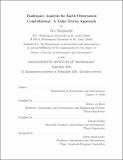Tradespace analysis for Earth Observation Constellations : a value driven approach
Author(s)
Magliarditi, Eric(Eric Andrew)
Download1227503351-MIT.pdf (13.91Mb)
Other Contributors
Massachusetts Institute of Technology. Department of Aeronautics and Astronautics.
Advisor
Olivier de Weck and Afreen Siddiqi.
Terms of use
Metadata
Show full item recordAbstract
In recent years, the Earth Observation (EO) industry has experienced rapid growth and development, but the tools to analyze EO constellations and space systems are lagging behind the curve. In particular, as costs continue to decrease to the point where constellations are treated like commodities, it is critical to look past cost and towards value creation when designing future EO constellations. In particular, there is an increasing need for value driven tradespace methods that can assist in the development of future EO space systems. Although there exist a few value driven approaches towards EO constellation design, they tend to be non-general and rely on detailed information such as expert knowledge or detailed probability distributions. Due to these limitations and the growing need for value driven trade methods, this thesis presents a new quantitative approach, using a novel Value Function, that can be applied generally to EO constellation trade studies. This thesis hypothesizes that the value generated by an EO constellation can be generalized in that the quantity and quality of data drives value to various stakeholders. By focusing on this simple hypothesis, this thesis will derive the Value Function to highlight these key attributes. The Value Function can be applied to a EO constellation, and using this new metric, various constellations can be compared against one another in a standardized way. To help show this, three case studies are used. The first case study, Case Study A, looks at two existing EO constellations: Landsat 8 and RapidEye. Their tradespaces are re-examined, and it is shown that the designs that are currently in operation are not optimal. There exists a single satellite Landsat-like architecture that generates 19.44% more value as compared to the current Landsat satellite in orbit. There also exists a five satellite RapidEye-like constellation that generates 35.76% more value as compared to the existing RapidEye constellation. The second case study, Case Study B, examines the make versus buy decision. In particular, it provides a hypothetical case study to determine if the Governor of California should purchase satellite imagery directly from Planet Labs, or if the state should fund a new constellation. This case study that shows the importance of understanding both costs and benefits when making important and high-investment decisions. For example, this thesis will discover an architecture that has 2 satellites, where each satellite is similar to a Planet Flock 2p CubeSat, and an orbital geometry that emphasizes California as compared to global coverage. The value ratio of this architecture is 5.01, and it is always greater than the cost ratio. This implies that it is in the state's best interest to build the constellation as opposed to purchasing imagery directly. Other architectures will be shown that do not lead to this same conclusion. The third case study, Case Study C, examines a proposed Synthetic Aperture Radar small satellite constellation, MicroX-SAR, by exploring a small set of potential architectures. These architectures are compared quantitatively using the Value Framework presented in this thesis, and it is shown that proposed constellations that are Sunsynchronous and at altitudes of 600 km generate the most value for a global region of interest. This information can be used when designing the mission parameters, such as orbital geometry, that will be important for constellation implementation. Overall, this thesis contributes a new model to evaluate EO constellations that relies on value driven methods as opposed to commonly used cost based metrics.
Description
Thesis: S.M., Massachusetts Institute of Technology, Department of Aeronautics and Astronautics, September, 2020 Cataloged from student-submitted PDF of thesis. Includes bibliographical references (pages 169-176).
Date issued
2020Department
Massachusetts Institute of Technology. Department of Aeronautics and AstronauticsPublisher
Massachusetts Institute of Technology
Keywords
Aeronautics and Astronautics.